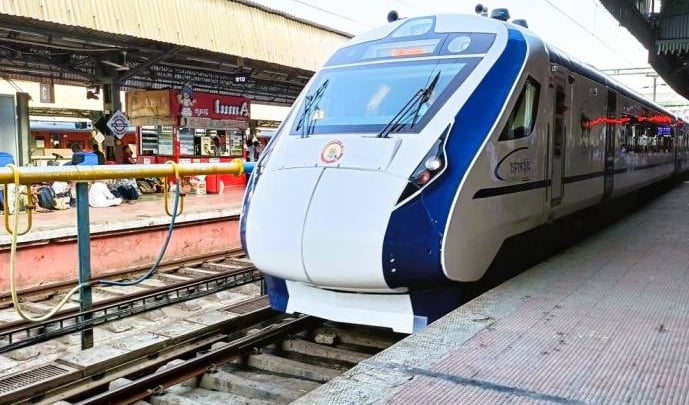Howrah to Puri Train Guide | Timings, Classes & Travel Tips
Explore the best trains from Howrah to Puri including Vande Bharat, Shatabdi & Express options. Get train timings, class details & essential travel tips.
PURI
Arghyaraj Basu
6/20/20256 min read
The Howrah-Puri route is well-served by a variety of trains, each offering a distinct travel experience:
Vande Bharat Express (22895):
Duration: Approximately 6 hours 40 minutes.
Frequency: Six days a week (except Thursdays).
Classes: AC Chair Car (CC) and Executive Class (EC).
Experience: This is the premium, fastest, and most modern option. Vande Bharat trains are known for their aircraft-like interiors, automatic doors, bio-toilets, and comfortable recliner seats. Executive Class offers wider 2x2 seating, sometimes with LCD screens and headphones. Catering is included in the fare, typically serving breakfast/lunch depending on travel time. Ideal for those prioritizing speed, comfort, and a contemporary travel experience.
Shatabdi Express (12277):
Duration: Around 7 hours 45 minutes.
Frequency: Daily.
Classes: AC Chair Car (CC) and Executive Class (EC).
Experience: A reliable daytime intercity train. Shatabdi Express is known for its punctuality and provides comfortable seating with good legroom. Catering is usually provided, serving meals and refreshments. It's a popular choice for a swift, comfortable day journey, offering a scenic view of the changing landscapes.
Howrah - Puri SF Express (12837):
Duration: Approximately 8 hours 55 minutes.
Frequency: Daily.
Classes: 1A (First AC), 2A (AC Two-Tier), 3A (AC Three-Tier), 3E (AC Economy), Sleeper (SL).
Experience: This is an excellent overnight option, allowing you to save on a night's accommodation.
1A (First AC): The most luxurious, offering private lockable cabins (coupes with 2 berths or cabins with 4 berths), often with washbasins. Bedding is provided.
2A (AC Two-Tier): Open bays with four berths (two upper, two lower) and two side berths (one upper, one lower). Curtains for privacy. Bedding is provided. More spacious than 3A.
3A (AC Three-Tier): Open bays with six berths (three upper, three middle, three lower) and two side berths (one upper, one lower). Bedding is provided. More economical AC option.
3E (AC Economy): Similar to 3A but with an additional middle berth on the side, making it slightly more compact. Often a very cost-effective AC choice. Bedding typically included.
SL (Sleeper Class): Non-AC, basic sleeping berths (three tiers in open bays, two side berths). No bedding provided, so carry your own sheet/light blanket. This class offers an authentic, vibrant Indian train experience with open windows (mesh-protected).
Dhauli Express (12821):
Duration: Around 9 hours.
Frequency: Daily.
Classes: Chair Car (CC), Second Seating (2S), Sleeper (SL), 3A, 3E.
Experience: A daytime train departing from Shalimar. Offers a mix of seating and sleeping options. 2S is non-AC seating, a budget-friendly option for those who don't mind a simple seat.
Sri Jagannath Express (18409):
Duration: Approximately 9 hours 40 minutes.
Frequency: Daily.
Classes: 1A, 2A, 3A, Sleeper (SL).
Experience: Another popular overnight train from Shalimar, ensuring an early morning arrival in Puri, giving you a full day to explore.
On-Board Experience and What to Expect:
Long-distance Indian train journeys are an experience in themselves. Expect vendors to board at major halts, offering everything from local snacks and chai to books and toys. While pantry cars are available on many express trains providing meals (often pre-booked or ordered on board), it's always wise to carry your own water and some snacks. Charging points are usually available in AC coaches (1A, 2A, 3A, EC, CC) but can be limited in Sleeper Class. Bio-toilets are becoming standard, improving hygiene. The camaraderie among passengers, sharing stories, food, and laughter, is a defining feature of Indian train travel.
Booking Your Ticket: The Digital Age
Booking your train ticket in India is primarily done through the official IRCTC (Indian Railway Catering and Tourism Corporation) website or its mobile app. Other popular travel portals also facilitate bookings.
Essential Booking Tips:
Advance Booking: Indian trains, especially popular routes like Howrah-Puri, can get booked months in advance, particularly during peak seasons (festivals like Durga Puja, Diwali, Rath Yatra, or summer holidays). The Advance Reservation Period (ARP) is generally 120 days (4 months) for most trains. Book as soon as your travel plans are firm.
Station Codes: Remember to use the correct station codes: HWH for Howrah, SHM for Shalimar, and PURI for Puri.
Understanding Quotas:
General Quota (GN): The most common quota with the largest number of seats, available for booking well in advance.
Tatkal Quota (TQ): For urgent, last-minute travel. Booking opens one day before the journey's originating station date (10 AM for AC classes, 11 AM for non-AC classes). Fares are higher, and availability is limited.
Premium Tatkal Quota (PT): Similar to Tatkal but with dynamic pricing, meaning fares increase with demand.
Ladies' Quota: A small number of berths reserved for female passengers traveling alone or with a child under 12, usually in Sleeper and 3A classes.
Lower Berth/Senior Citizen Quota (LB/SS): For female passengers 45+ and male passengers 60+ traveling alone or in pairs, ensuring a lower berth.
Foreign Tourist Quota: For foreign nationals and NRIs with valid visas, typically at a higher fare.
Always check your PNR (Passenger Name Record) status if your ticket is waitlisted; many waitlisted tickets get confirmed closer to the travel date.
Crucial Travel Tips for a Smooth Journey
Arrive Early: Especially at a large station like Howrah, arriving at least 45-60 minutes before departure gives you ample time to locate your platform and coach without stress.
Pack Smart: Carry only essentials in an easily manageable bag. Include a small hygiene kit (hand sanitizer, wet wipes, toilet paper), a personal water bottle (refillable), comfortable clothes, any necessary medications, and chargers/power banks for electronics. For overnight journeys in Sleeper class, a light blanket or sheet is a good idea.
Secure Your Luggage: While train travel in India is generally safe, it's wise to use a chain and padlock to secure your main luggage to the provided hooks under the berths, especially during overnight journeys. Keep valuables like wallets, phones, and documents on your person.
Stay Aware: Be mindful of your surroundings, especially at crowded stations. Avoid accepting food or drinks from strangers.
Food and Beverages: While train food is available, carrying some homemade snacks is recommended. At major stations, licensed vendors offer a variety of local delicacies, but choose wisely.
Respect Co-passengers: Indian trains are shared spaces. Be mindful of noise levels, especially at night.
Understand the Berth System: Familiarize yourself with how berths convert from seats, especially in Sleeper and AC classes.
Exploring Puri and Its Environs: A Coastal and Spiritual Retreat
Upon arrival in Puri, you step into a city where ancient spirituality meets the tranquil beauty of the Bay of Bengal.
Shri Jagannath Temple: The spiritual heart of Puri, this 12th-century marvel is dedicated to Lord Jagannath (Lord of the Universe), a form of Vishnu, along with his siblings Balabhadra and Subhadra. The temple's architecture follows the Kalinga style, characterized by its towering shikhara (spire) and intricate carvings. Non-Hindus are generally not permitted inside the main temple premises, but they can view its towering structure from nearby rooftops. The daily rituals, the unique wooden deities, and the Mahaprasad (sanctified food) offered to the deities are central to its ethos. Be aware of strict dress codes and a ban on leather items inside.
Puri Beach: A vast stretch of golden sand lining the Bay of Bengal, Puri Beach is ideal for leisurely strolls, witnessing stunning sunrises, and simply relaxing by the waves. It's also famous for the incredible sand art by renowned artists, often depicting religious or contemporary themes. Activities include camel rides, horse rides, swimming (with lifeguards often present), and admiring the local fishing boats. Swargadwar, a section of the beach, is considered sacred.
Konark Sun Temple (approx. 35 km from Puri): A UNESCO World Heritage site, the Konark Sun Temple is an architectural masterpiece from the 13th century, built by King Narasimhadeva I. Designed as a colossal chariot for the Sun God Surya, with twelve pairs of intricately carved wheels (representing the 12 months) and seven horses (representing days of the week). Though much of the main temple is in ruins, the Jagamohana (assembly hall) and parts of the Natamandira (dance hall) still stand, showcasing exquisite carvings that depict daily life, mythological figures, and sensuous art. It's a profound experience to witness the blend of art, astronomy, and devotion here.
Chilika Lake (approx. 50 km from Puri): Asia's largest brackish water lagoon, Chilika Lake is a paradise for nature lovers and birdwatchers. From November to February, it becomes the wintering ground for millions of migratory birds from Siberia, Central Asia, and other parts of the world.
Nalaban Island: A designated bird sanctuary within the lake, offering incredible birdwatching opportunities.
Irrawaddy Dolphins: Head to Satapada, on the eastern side of the lake, for boat rides where you can spot these rare freshwater dolphins.
Kalijai Temple: Located on an island in the lake, it's a popular pilgrimage spot. A boat ride on Chilika Lake offers a serene escape, surrounded by stunning natural beauty.
Raghurajpur Artist Village (approx. 14 km from Puri): This heritage crafts village is a vibrant showcase of traditional Odishan art. It is most famous for Pattachitra paintings, a traditional cloth-based scroll painting dating back to the 5th century BC, depicting mythological tales, especially those of Lord Jagannath and Krishna. You can witness artists at work, creating these intricate pieces on specially prepared Tussar silk. The village also excels in palm leaf engravings, stone and wood carvings, and handmade toys. It’s an ideal place to pick up authentic souvenirs and support local artisans.
The Best Time to Visit Puri
The ideal time to visit Puri is during the cooler, drier months from October to March. The weather is pleasant, making it perfect for sightseeing and beach activities. If you plan your visit in June or July, you might be able to witness the grand Rath Yatra (Chariot Festival), an immensely vibrant and spiritual spectacle where the deities are brought out of the temple and paraded on grand chariots to the Gundicha Temple and back. This event draws millions and requires meticulous planning for accommodation and viewing spots.


